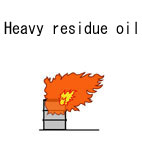| Case Name |
Leakage and fire of heavy residue oil from a drain valve after pump switching at a vacuum distillation unit of a refinery |
| Pictograph |

|
| Date |
May 23, 1990 |
| Place |
Kawasaki, Kanagawa, Japan |
| Location |
Refinery |
| Overview |
Heavy residue oil leaked out from the drain valve around an over-flash pump of a vacuum distillation unit in K refinery of T petroleum, and a fire broke out. Sludge entered the drain valve during a turnaround shutdown in the previous year, the valve could not be closed completely, sludge was dissolved by heat and vibration during one year of operation, and heavy residual oil leaked on switching the pump. Another cause was that caps were not put on at the end of the drain nozzle. |
| Incident |
Operation of an over-flash pump was switched from pump A to B to clean a blocked strainer at the pump A side. Afterwards, heavy residue oil leaked out from the drain valve at the pump B side, and ignited. The operating temperature at the position of the leak was about 315 °C.
Over-flash pump: At this unit, a pump which was used to send heavy oil residue to the pre-heating furnace from the bottom of the column for re-evaporation. |
| Processing |
Manufacture |
| Individual Process |
Distillation |
| Process Flow |
Fig2.Schematic flow sheet
|
| Substance |
Heavy oil |
| Type of Accident |
Leakage, fire |
| Sequence |
From May to June, 1989; Turnaround shutdown maintenance was carried out.
After start-up, pumps A and B were driven alternately.
On May 23rd, 1990.
At about 14:00; For blockage of a suction strainer of pump A, pump B was started instead of pump A, and the strainer of pump A was cleaned. Operation of the pump B was continued after cleaning.
At 19:56: A low flow alarm of pump B operated in the control room. A fire was found near pump B when an operator rushed to the site. |
| Cause |
At turnaround shutdown maintenance of the previous year (1989), sludge, etc. remained in a drain valve, which was opened to discharge oil in the system. Therefore, the valve could not be closed tightly. During operation, sludge etc. melted and was deformed by heat and vibration. As a result, a penetrated part was formed in the closed division, and it is considered that the heavy residue oil escaped and ignited.
There was a possibility of ignition due to static electricity. |
| Countermeasures |
1. Taking measures to thoroughly remove sludge etc. from drain valves. The concrete method is as follows. A drain line must be used when nitrogen and/or steam is released after an airtight test at turnaround shutdown maintenance. At that time, sludge etc. that might remain in the drain line has to be removed by nitrogen/steam. In addition, confirmation of removal of sludge is executed by stopping nitrogen/steam with the valve closed.
2. Capping all the end of the drain and preparing the list of caps and checking them periodically with the list.
3. Employees should be given fire prevention education and training, including a report system. |
| Knowledge Comment |
There are many accidents during operation originating from periodic check work. This accident shows that it is important to consider safety measures with the premise that a valve might leak. Although there are various causes of leaks, it is necessary to pay attention to solids such as sludge when heavy oil is treated. |
| Background |
Two problems can be pointed out.
1. With respect to operation, not capping the drain nozzle at start-up could be a cause. Moreover, the nozzle was left uncapped for about one year. This is a problem of operation management.
2. It is very common at a refinery that solids such as sludge in heavy oil accumulate in the grooves of a valve. The true cause was that no countermeasures were taken against this. |
| Reason for Adding to DB |
Example of leakage from a drain valve after switching a pump |
| Scenario |
| Primary Scenario
|
Carelessness, Insufficient Precaution, Inadequate Handling, Organizational Problems, Poor Management, Slackness of Management, Regular Movement, Careless Movement, Omission, Malicious Act, Rule Violation, Safety Rule Violation, Bad Event, Thermo-Fluid Event, Loosen the pluggings, Secondary Damage, External Damage, Fire
|
|
| Sources |
Kawasaki City dangerous material safety research association, Cases of accidents. Examples of accidents with FTA, pp. 23-25 (1997).
Kawasaki City Fire fighting station, Prevention division, Peace section. Outline of fire at vacuum distillation column in the gasification-desulfurization unit of T Petroleum Co. Ltd. K refinery. Material of the Kawasaki City Complex safety countermeasure committee.
|
| Physical Damage |
Piping burned. Some instruments were destroyed by fire. Heavy residue oil in total 900 L leaked, adhered to the floor, and partially burned. |
| Financial Cost |
¥1.8 million. (Material of the Kawasaki City Complex safety countermeasure committee) |
| Field |
Chemicals and Plants
|
| Author |
KOSEKI, Hirosi (National Research Institute of Fire and Disaster)
TAMURA, Masamitsu (Center for Risk Management and Safety Sciences, Yokohama National University)
|
|